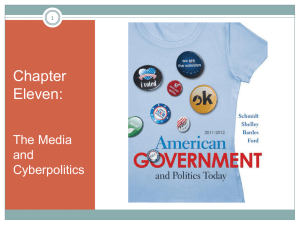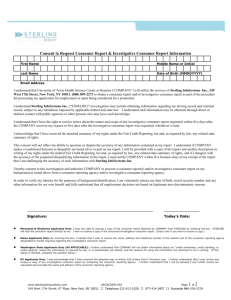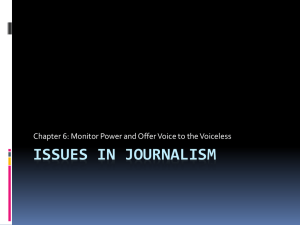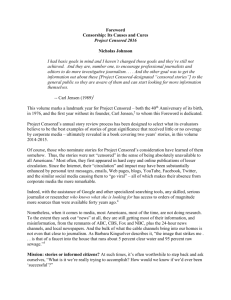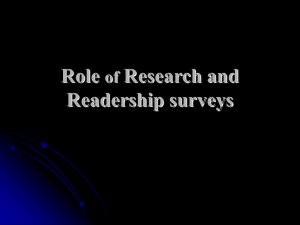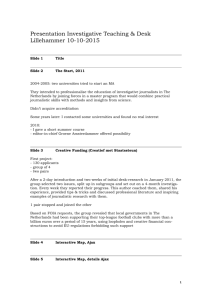Investigative Journalism
advertisement
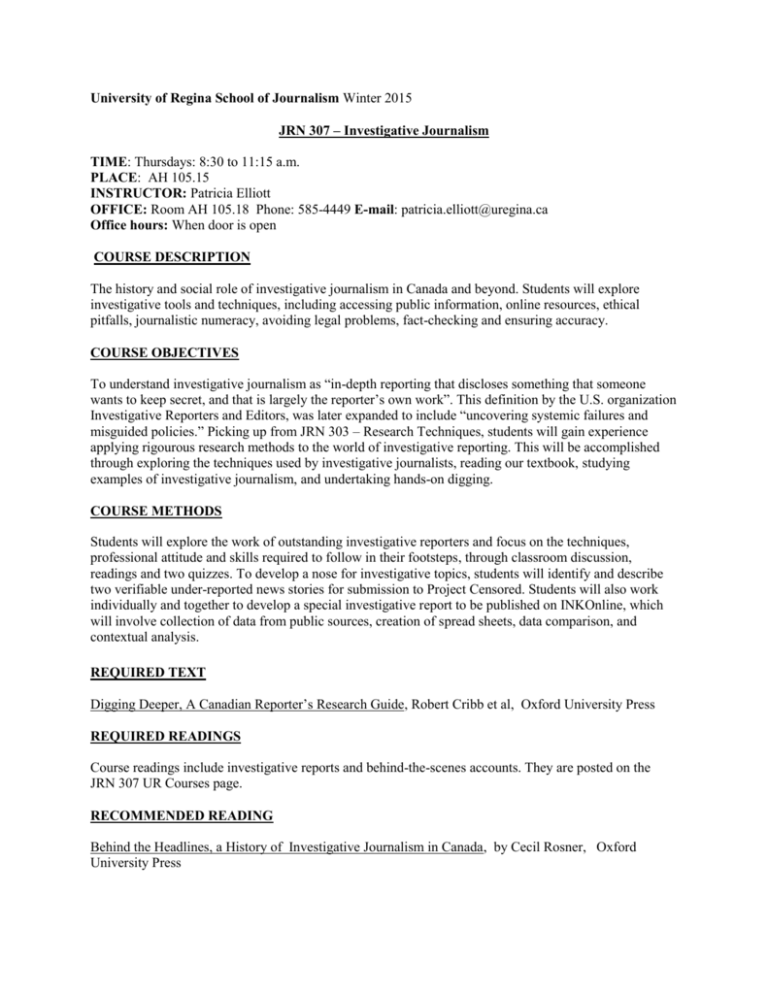
University of Regina School of Journalism Winter 2015 JRN 307 – Investigative Journalism TIME: Thursdays: 8:30 to 11:15 a.m. PLACE: AH 105.15 INSTRUCTOR: Patricia Elliott OFFICE: Room AH 105.18 Phone: 585-4449 E-mail: patricia.elliott@uregina.ca Office hours: When door is open COURSE DESCRIPTION The history and social role of investigative journalism in Canada and beyond. Students will explore investigative tools and techniques, including accessing public information, online resources, ethical pitfalls, journalistic numeracy, avoiding legal problems, fact-checking and ensuring accuracy. COURSE OBJECTIVES To understand investigative journalism as “in-depth reporting that discloses something that someone wants to keep secret, and that is largely the reporter’s own work”. This definition by the U.S. organization Investigative Reporters and Editors, was later expanded to include “uncovering systemic failures and misguided policies.” Picking up from JRN 303 – Research Techniques, students will gain experience applying rigourous research methods to the world of investigative reporting. This will be accomplished through exploring the techniques used by investigative journalists, reading our textbook, studying examples of investigative journalism, and undertaking hands-on digging. COURSE METHODS Students will explore the work of outstanding investigative reporters and focus on the techniques, professional attitude and skills required to follow in their footsteps, through classroom discussion, readings and two quizzes. To develop a nose for investigative topics, students will identify and describe two verifiable under-reported news stories for submission to Project Censored. Students will also work individually and together to develop a special investigative report to be published on INKOnline, which will involve collection of data from public sources, creation of spread sheets, data comparison, and contextual analysis. REQUIRED TEXT Digging Deeper, A Canadian Reporter’s Research Guide, Robert Cribb et al, Oxford University Press REQUIRED READINGS Course readings include investigative reports and behind-the-scenes accounts. They are posted on the JRN 307 UR Courses page. RECOMMENDED READING Behind the Headlines, a History of Investigative Journalism in Canada, by Cecil Rosner, Oxford University Press 2 Tell Me No Lies,Investigative Journalism and its triumphs, by John Pilger, editor, 2004, Jonathan Cape, London Highly Recommended: Individual memberships in the Canadian Association of Journalists. (www.caj.ca) Also note this web site: http://www.jsource.ca TENTATIVE SCHEDULE (To be adjusted as required) Week 1 – Thursday, January 8 Getting started. What is the point of investigative journalism? Thinking like an investigative journalist. Getting into the investigative mood. What are some major investigative reports in recent years that made a difference? What stories are missing from the news? Syllabus overview. Introduction to spreadsheets. An introduction to Project Censored. Week 2 – Thursday, January 15 Assigned reading for discussion: Digging Deeper, Chapter 1. What does Canada’s investigative journalism history tell us? Why ethics matter: two examples. In-class Investigative Project lab work: An introduction to Public Accounts. Step 1 – Compile Week 3 – Thursday, January 22 Project work: Prepare online special report, Step 1. Week 4 – Thursday, January 29 Assigned readings: The Story of Watergate (National Post); The Story Behind the Rob Ford Story (The Walrus). Compare and contrast. What were the major sources? What were the legal and ethical risks? What were the impacts? In-class project work: Step 2 – Compare Week 5 – Thursday, February 5 Assigned readings: Digging Deeper, Chapter 2; The Airbus Affair (National Post) Ethics and technique: Canadian journalists and the Airbus Affair. In-class project work: Prepare online special report, Step 2 Week 6 - Thursday, February 12 Review of Chapter 4, Digging Deeper: Using Public Records Assigned reading: Shawinigate: A Timeline Bringing down the government: Shawinigate Mid-Term Quiz Thursday, February 19 - Reading Week. No class Week 7 - Thursday, February 26 Assigned reading: Digging Deeper, Chapter 9: Following the Money In-class project work: Step 3 – Connect Project Censored VIN Reports Due Week 8– Thursday, March 5 Assigned readings: Wage Slaves (Saturday Night) and The $3 Million Question (Prairie Dog and Planet S) Project work: Step 3 – Connect 3 Week 9 – Thursday, March 12 Project work: Step 3 online report Week 10 – Thursday, March 19 Assigned reading: The My Lai Massacre Gum-shoe detective work and charting your own path when publishers aren’t interested: Seymour Hersh and the My Lai Massacre Project work: Step 4 – Context Week 11 – Thursday, March 26 Project work: Step 4 online report Week 12– Thursday, April 2 Investigative Project Reports due Final Quiz Classroom discussion: Describe one of your two VINs. Week 13 – Thursday, April 9 Wrap-up discussion. Online special investigative report completed and published. ASSIGNMENT SUMMARY Verified Independent News stories (VINs): Worth 15 points each (total 30 points). Due Feb. 26. Students will submit two VINs according to the guidelines and instructions of Project Censored. Assignment instructions and marking criteria are posted on the UR Courses site. Investigative Project Report: Worth 30 points. Due April 2. Each student will be responsible for researching, analysing and describing an assigned portion of an online Special Report. The student’s research will be presented in the form of an approx. 1,000-word analysis written in journalistic style. Assignment instructions and marking criteria are posted on the UR Courses site. Mid-term Quiz: Worth 15 points. Feb. 12 The Quiz will cover readings and classroom lectures up to and including Feb. 12. Final Quiz: Worth 15 points. April 2. The Quiz will cover readings and classroom lectures up to April 2. Attendance and in-class participation: Worth 10 points. Ongoing. Students are expected to have read the assigned articles and jotted down notes for in-class discussion. This course also includes in-class time for students to work on their investigative research under the supervision of the instructor. When not meeting with the instructor, you are to be working on the investigations, helping prepare material for the online special report, or studying your readings. If any student is found in the broadcast suites during class time or doing work for other classes, lab privileges will be revoked for the whole class, to be replaced by lectures, with the investigative assignments to be done as homework. 4 How to Find, Evaluate and Summarize Validated Independent News Stories (VINs) INSTRUCTIONS FROM PROJECT CENSORED Find a Candidate Story A censored news story reports information that the public has a right and need to know, but to which the public has limited access. Search independent news sources to find candidate stories. See the Project Censored website for recommended independent news sources: http://www.projectcensored.org/independent-news-links/ http://www.projectcensored.org/independent-periodicals-webzines/ http://www.censorednews.org/ [MORE LINKS ARE ON THE UR COURSES PAGE] Evaluate Your Candidate Story's Strength The strongest candidate stories—those most likely to gain a spot among the top censored stories in a given year—are important, timely, fact-based, well documented, and under-reported. Once you have found a candidate story, test its significance by considering these questions: 1. Is it important? The more people that the story affects, the more important it is. Be careful to consider indirect impacts. For example, a story about electronic waste disposal in Africa might seem like it only involves the people exposed to the toxic waste. But the problem of electronic waste disposal includes Western consumers (mostly North Americans and Europeans) who discard as much as 40 million tons of electronic waste each year. So, the story involves a wider circle of people and is more important than it might first seem. 2. Is it timely? Only stories published since March 2014 will be considered for Censored 2016. Recent stories on older events will be considered if they report new, important information. 3. Is it fact-based and well documented? The story's accuracy and credibility is crucial. Dramatic claims and seductive rhetoric do not matter if the journalist fails to provide specific evidence to support the story. How many different sources does the story use? How credible is each source? A story based on a number of reliable sources is harder to dispute than one based on a single good source or several biased sources. If your story cites other published work (for example, a scientific study, government document, or another news story), track back to that source and read it. Does your story accurately depict the original? 4. Has the corporate media ignored or under-reported the story? Evaluate your story's coverage by using a news database (such as LexisNexis News, part of Lexis-Nexis Academic; Proquest Newstand; or Newspaper Source Plus) to search for corporate coverage of it. Check with your instructor or your school's reference librarian to learn what news databases you can access. Experience shows that Google News is not always reliable; use it as a last resort. The clearest "censored" stories are ones that corporate media have completely ignored. Candidate stories that received some corporate coverage may still be considered "censored" if corporate coverage leaves the reader with an incomplete or distorted understanding of the story. 5. As you research your candidate story, be alert for related stories that (1) contain information contrary to your original story, (2) were published before your original story, or (3) contain more complete information than your first story. You may decide a second story is better than your first, in which case continue your work now using the second story. Or you may conclude that the second story supports the first and should be included along with it. 5 Summarize Your Candidate Story All candidate stories submitted to Project Censored should use the following format. Incomplete or improperly formatted stories will be returned for revision. TITLE This captures the story's most important point in approximately five to ten words. SUMMARY (200-250 words maximum) * The first paragraph should provide a specific, concise and factual summary of the story's most important point. Use a summary lead to place this essential information up front. Your first sentence should introduce what happened, where, and when. Be specific. Use active verbs. Avoid passive constructions (for example, "Civilians were targeted") that tend to hide agency (who did what). Your summary lead should address the skeptical reader's questions, "So what? Why is this important?" If the main point of your story is controversial, which is often true for Project Censored stories, an attribution will add strength to your lead paragraph. For example, In January 2012, Fairtest, the National Center for Fair and Open Testing, reported that a decade of No Child Left Behind (NCLB) policies has actually slowed the rate of education progress. For more on how to write a lead or opening paragraph, including several examples of summary leads, see http://owl.english.purdue.edu/owl/resource/735/05/ The next paragraph should go into more detail, elaborating on the story's main point and/or introducing secondary points. Good detail might include who stands to benefit from the action or policy in question, as well as who (if anyone) it harms. A final paragraph should address corporate media coverage of the story. This is often as important as your story's summary lead. It is essential that you do a thorough job of researching your story's coverage using a reliable news database. If there is no corporate media coverage of your story, state so directly and indicate a date as of which this was true. If your story has gotten some corporate news coverage, then identify what corporate news organizations covered the story, and when. In this case be sure to describe how the independent news story you are summarizing goes beyond the coverage provided by the corporate media. If you cannot see a difference, you may need to reconsider whether your story is actually a "censored" story. REFERENCES Following the summary, give a complete reference for the story using the Chicago Manual of Style format. For example: Almerindo Ojeda, “Death in Guantánamo: Suicide or Dry Boarding?” Truthout, November 3, 2011, http://www.truth-out.org/news/item/4511:death-in-guantanamo-suicide-or-dryboarding. See http://owl.english.purdue.edu/owl/resource/717/01/ for more details on Chicago style. If your summary draws on multiple stories, give a reference for each one. STUDENT RESEARCHER(S): List each student researcher's name and, in parentheses, school affiliation. FACULTY EVALUATOR(S): List each faculty evaluator's name and, in parentheses, school affiliation. * * * * * Identifying, researching, and summarizing candidate stories will sharpen your critical thinking skills (including interpretation, evaluation, and explanation) and enhance your media literacy. Project Censored posts candidate stories accepted as Validated Independent News (VINs) online at http://www.projectcensored.org/category/validated-independent-news/ These VINs are considered for inclusion among the top 25 stories in Project Censored's annual book. Both online and in the book, we acknowledge the students and faculty who contribute VINs by name. Since 1976 these submissions have been Project Censored's lifeblood. We look forward to your contributions. Revised, August 2014, based on Peter Phillips' guidelines for Sonoma State University students. Thanks to Susan Maret, Susan Rahman and Kenn Burrows for their contributions. 6 Marking Criteria – Project Censored VINs Validated Independent News stories (VINs) report information and perspective that the public has a right and need to know, but to which it has limited access. Before being posted as a VIN, each story undergoes evaluation by student researchers and faculty evaluators to determine that it is important, timely, factbased, well documented, and under-reported in the corporate media. These VINs are candidates for inclusion among the top 25 stories in Project Censored’s annual book. A good VIN is: 1. Important. The story has broad implications that matter to the public. 2. Timely. The story took place and/or experienced a major new development after March 2014. 3. Accurate and verifiable. There are credible supporting sources. It has not been conclusively or near-conclusively debunked by credible sources. 4. Ignored or under-reported. It has not been the subject of mainstream media coverage. 5. Well written. It is presented in the required style and format, and employs active, engaging language. A potential three points will be assigned to each of the above characteristics, for a total of 15 points per VIN. It is highly important to read and follow the Project Censored VIN guidelines, posted on the UR Courses site. Structure your paragraphs and footnotes according to the instructions given. Assignment details: 2 VINs 200 – 250 words each Due Feb. 26 15 points each = 30 points Instructions and Criteria - Investigative Project On December 3, 2014, Saskatchewan’s provincial auditor, Judy Ferguson, released a report that stated the Saskatchewan government has increased spending on private consultants by 228 per cent over the past six years. She found that in 70 per cent of cases, the government could not document why a consultant had been hired, rather than using in-house staff. As well, 90 per cent of contracts failed to specify who the consultant should report to, or how the consulting work would be monitored and evaluated. Her report did not include specific details about the consultants – who they are, what they are paid, what Ministries they work for, and what type of services they provide. This semester’s investigative project will endeavour to fill in the missing details. Each student will be assigned a Ministry or Ministries to track. Using Public Accounts as a source, the student will prepare Excel spreadsheets for each Ministry, which will be combined and compared. The student will do research into the consultants and their work, and will provide background context, using a variety of sources, including corporate records, news reports, lists of political donors, and other relevant sources. The data will be compiled for presentation as an INK Online Special Report, with students working in teams to check facts, create illustrations, and prepare explanatory narratives and profiles. For a final project mark, students will submit an approx. 1,000-word journalistic analysis that describes his/her findings and relevant background information. 7 To guide this process, the assignment will be divided into four steps, with classroom lab time and guidance provided along the way. Links to major sources to be used are posted on the UR Courses site. Your files will be stored in DriveO@ARTS/JOURNLAB/Investigative/Investigative Project 2015, so that the information can be combined for use in the Special Report. Data Gathering and Analysis Steps 1. Compile Who are the consultants? How much were they paid? What services do they provide? 2. Compare How does this compare to: 2012-2013 (Previous year) 2008-2009 (First full year of Sask Party government) 2005-2006 (Last full year of NDP government) 3. Connect Who are the principle people behind the consulting companies? Where are their head offices? Are there any former government employees? How much do they / their companies donate to the Sask Party? Are there any organizational connections or conflicts? 4. Context What programs and policies are the Ministries attempting to put in place? What are the Ministry’s staffing trends? What other background information helps make sense of the data? Special Report On specified lab days, students will be rotated through three teams tasked with preparing and uploading information to the web. The teams will be: 1. Fact-checking: Checking each spreadsheet against the original sources. 2. Illustration: Preparing graphs, compiling photos, setting up interactive elements. 3. Narrative: Explanatory articles, company and ministry profiles, etc. Assignment Marking A good final analysis report is: 1. Accurate. The numbers check out, and background information is error-free. 2. Thorough. No consultant is left behind. Every effort has been made to identify who the players are, and what services they provide. 3. Contextual. The student understands the Ministry’s main functions, and can articulate major trends in Ministry direction and staffing. 4. Well written. Complex data-heavy information is presented in a clear and engaging style. Sidebars may be used to profile companies/people or to highlight interesting facts. 5. Enthusiastic. The student digs into classroom lab time, is excited about revealing information to the public, works hard to gather information, and is an active participant in preparing the Special Report. Each of these characteristics will be assigned six points for a total of 30 points. Assignment Basics Approx. 1,000-word final analysis report. Due April 2.


